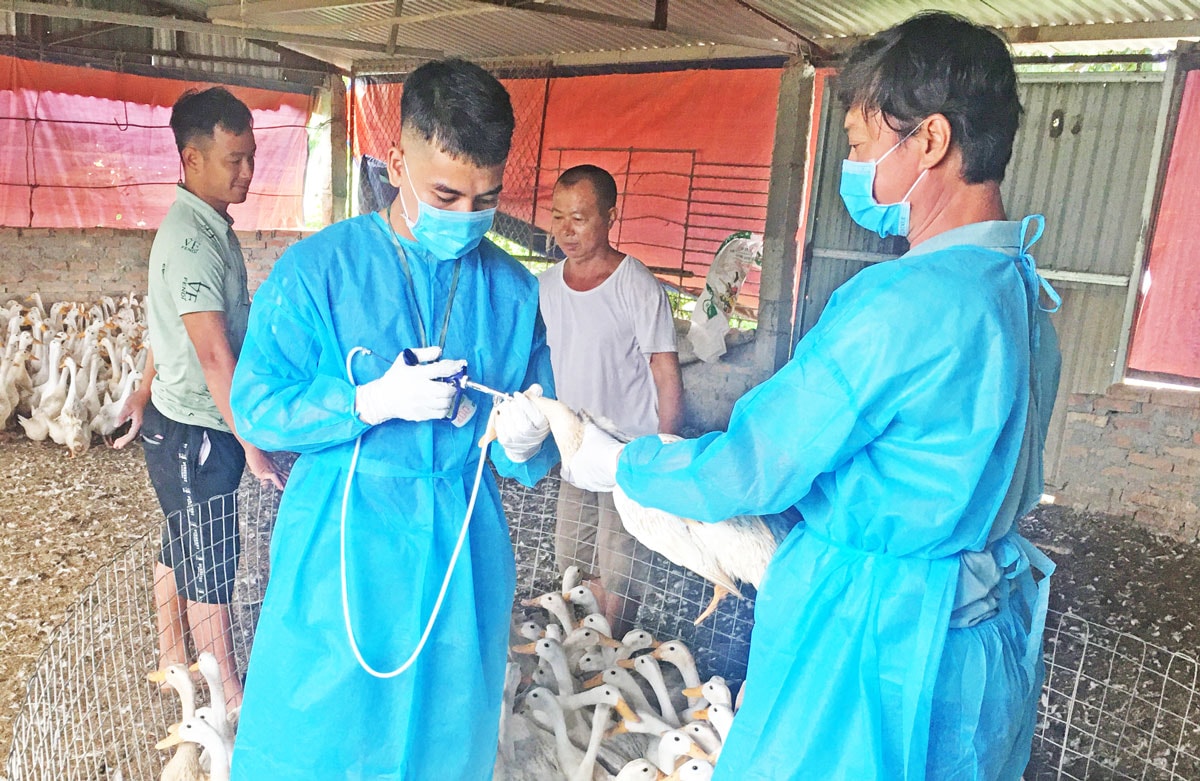From now until the end of the year, the demand for livestock and poultry meat will increase, while the weather will change abnormally, affecting the resistance of livestock.
To ensure food supply for consumers, the agricultural sector proactively implements measures to prevent and control livestock and poultry diseases with the motto of prevention as the main focus.
 Veterinary staff of Chuong My district vaccinate poultry against disease. Photo: Ngoc Son
Veterinary staff of Chuong My district vaccinate poultry against disease. Photo: Ngoc Son
Ms. Nguyen Thi Lien in Van Hoa commune (Ba Vi district) said that her family is raising 10 cows. In animal husbandry, the most important thing is disease prevention. With the guidance of local veterinary staff, her family always pays attention to fully vaccinating their animals twice a year. In addition, before and during winter, her family injects vitamins and minerals to increase the animals’ resistance. With a large number of cows, in winter, the family collects straw and stubble to store for the cold days when they cannot graze.
Similarly, Director of the Phuc Tho Agricultural Products Production and Trading Cooperative (Phuc Tho district) Nguyen Hung Thinh said that to ensure the safety of the pig herd, the cooperative regularly and strictly implements disease prevention and control work; carefully restores the herd, strictly controls the selection of breeds and animal feed of clear origin; regularly monitors the pig herd to have timely handling when an epidemic occurs, especially the prevention and control of African Swine Fever.
Head of the Hanoi Department of Animal Husbandry, Fisheries and Veterinary Medicine Nguyen Dinh Dang said that since the beginning of the year, the livestock and poultry in the city have been basically stable; common diseases have occurred sporadically, with low rates of illness and death. Specifically: The buffalo and cow herds mainly suffer from septicemia, surgical diseases, obstetric diseases, diarrhea, pneumonia, etc., with the sickness rate per total herd being 0.53%; the poultry herds mainly suffer from Newcastle disease, septicemia, duck cholera, Gumboro, with the sickness rate per total herd being 0.12%, etc.
In addition, the Department guides and urges veterinary facilities to closely monitor epidemics, promptly report information, investigate and verify when an outbreak occurs. The Department also took 100 swab samples to test and monitor the circulation of avian influenza viruses; in coordination with the US Centers for Disease Control and Prevention (CDC), 21 pooled swab samples (throat, feces) were taken to test for avian influenza viruses…
According to Deputy Director of the Department of Agriculture and Rural Development Ta Van Tuong, from now until the end of the year, localities will proactively deploy measures to prevent and control livestock and poultry diseases with the motto of disease prevention as the main focus, timely treatment combined with synchronous implementation of disease management and monitoring measures to villages, hamlets, and livestock households; early detection, localization, control, timely and thorough handling of dangerous diseases arising in small-scale animals for newly invasive diseases and mutations of disease-causing viruses; ensuring stable and sustainable development of livestock production; protecting people’s health.
In addition, localities manage the slaughter of livestock and poultry in a controlled manner, ensuring disease-free livestock farming, gradually reducing small-scale slaughter and small-scale farming in residential areas; improving the quality of breeding stock, maintaining, conserving and developing highly effective indigenous breeds in Hanoi; developing disease-free livestock farming in ecological agricultural production areas; instructing livestock farmers to implement biosafety measures, hygiene, disinfection and sterilization of barns and livestock environments; mobilizing the entire population to clean village roads and alleys, dredge sewers, clear weeds and trees around houses and barns, sweep and collect waste to biogas tanks, ensuring biosafety in livestock farming.
In particular, in case of an epidemic, the owner of the livestock facility must immediately report to the management agency and local authorities, and handle the situation according to the direction of the professional sector. Communes and towns must strengthen supervision of the transportation, trading, and slaughter of livestock and poultry by local people; carry out disinfection and sterilization campaigns, combine with strict supervision and control of livestock farming areas, markets, and trading and slaughtering points for livestock and poultry in the area…
Source: hanoimoi.vn
